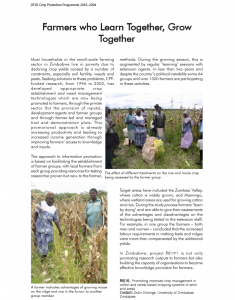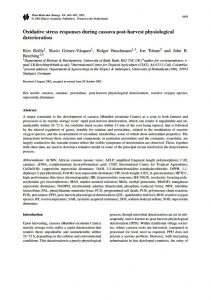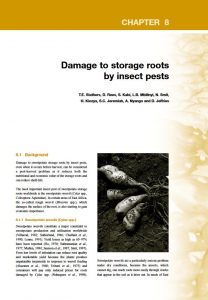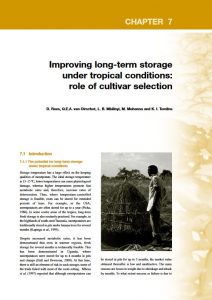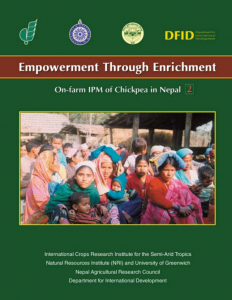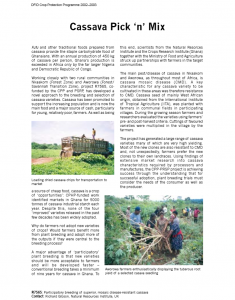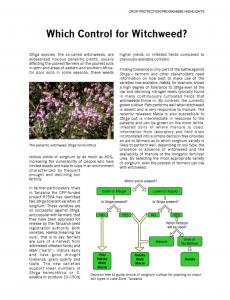Welcome to the AgShare.Today Resource Centre
The AgShare.Today Resource Centre brings together a collection of resources related to agriculture. These include open access scientific journals and best practice guides that can be used for background reading and to support research initiatives. The AgShare Featured Resource showcases a new document each month that the AgShare team recommends to all members.
This short report highlights a ‘learning by doing’ approach to promoting research outputs to farmers in Zimbabwe. Farmers were able to test methodologies and feed back their assessments to extension agents.
Published by: DFID, Year: 2004, Pages: 1, File type: External link
Read more Access resource on external site
This review describes recent progress in research on CMGs and CBSV in sub-Saharan Africa, examines the dynamic nature of their status, and provides insights into the major control initiatives that are required to tackle them.
Published by: Plant virology in sub-Saharan Africa, Year: 2003, Pages: 37, File type: External link (400 KB)
Read more Access resource on external site
Post-harvest deterioration of cassava occurs rapidly and renders the crop unpalatable and unmarketable. This is attributable to oxidative burst, altered regulation of genes and accumulation of secondary metabolites. Interactions between these enzymes and compounds, together with other data, are used to develop a model of some the principal events involved in the deterioration process.
Published by: Plant Molecular Biology, Year: 2003, Pages: 17, File type: PDF (696 KB)
Read more Open resource Download resourceThis is Chapter 8 of the book Sweetpotato postharvest assessment: Experiences from East Africa. The chapter focuses on a collaborative study between Tanzanian institutes and the Natural Resources Institute (NRI) in the UK, looking at damage to storage roots by weevils.
Published by: Natural Resources Institute, Year: 2003, Pages: 10, File type: PDF
Read more Open resource Download resourceThis is Chapter 5 of the book Sweetpotato postharvest assessment: Experiences from East Africa. It looks at studies on breeding for extended shelf-life in sweetpotato.
Published by: Natural Resources Institute, Year: 2003, Pages: 16, File type: PDF (888 KB)
Read more Open resource Download resourceThis is Chapter 7 of the book Sweetpotato postharvest assessment: Experiences from East Africa. It examines the effect of cultivar selection on long-term storage success.
Published by: Natural Resources Institute, Year: 2003, Pages: 8, File type: PDF (560 KB)
Read more Open resource Download resourceThis study shows that the adoption of integrated pest management technology can result in socio-economic emancipation of poor populations, freeing them from usurers.
Published by: DFIDICRISAT, Year: 2003, Pages: 31, File type: PDF (451 KB)
Read more Open resource Download resourceThis document describes the participatory effort between farmers and researchers to breed cassava varieties resistant to cassava mosaic disease. Together, farmers and researchers evaluated the yields of varieties planted for subsequent multiplication and adoption.
Published by: DFID, Year: 2003, Pages: 1, File type: External link (487KB)
Read more Access resource on external site
Striga-resistant cultivars and farming guidance to manage witchweed impact on sorghum yields in Tanzania
This article highlights the identification of sorghum varieties that are Striga-resistant and guides farmers on the cultivar to plant and fertiliser to use, depending on soil type.
Published by: DFID, Year: 2003, Pages: 1, File type: External link (533KB)
Read more Access resource on external site
This project evaluated technologies relating to bacterial wilt and seed-tuber production systems. Areas addressed were (1) biocontrol agents against bacterial wilt, including the approval of a biological control agent (BCA) for testing in Kenya, and (2) small-scale seed-tuber (SPSS) production system for trialling and the monitoring of pests in Uganda.
Published by: Crop Protection Programme, Year: 2002, Pages: 48, File type: PDF (482 KB)
Read more Open resource Download resource
